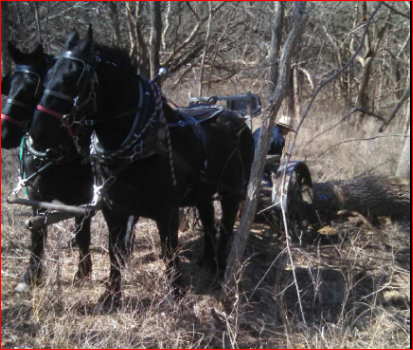“Horses still work best for modern day logging crews.”
While sophisticated technology and elaborately designed machines seem to dominate progressive industry today, that’s not always true.
Two teams of Percheron geldings were pulling big walnut logs out of the timber last week west of Williamsburg.
“Horses are much more efficient and easier to work with than other methods we’ve seen,” said Eli Troyer.
It was dinner time when Troyer and his sons Jonathan and Alvin along with Freeman Gingerich visited about cutting logs.
They had been working several days in Franklin and Osage counties cutting mostly walnut and some oak logs.
“We’re from New York but moved near Scranton when my other son Raymond bought a farm,” the senior Troyer said.
The Amish family does carpenter work during the summer and saws logs during the winter.
“That’s what we did in New York and it’s worked well the same way here in Kansas,” Troyer explained. As carpenters, the men typically do pole barn construction, roofing and other building renovation projects.
Area farmers are contacted by the loggers about harvesting logs from their timbers. “We typically saw logs for a 40-60 share with 60 percent of log value going to landowners,” Troyer said. “Sometimes, we have a 50-50 agreement and we have bought logs instead of working on a share.”
Alvin Troyer, youngest of the logging crew, was barefooted during dinner. Evidently, he’d gotten his feet wet and had a small twig fire burning to warmup his toes before afternoon work.
Against their belief, the loggers insisted they not have their pictures taken. “You can take photographs of the horses and the logs; that’s okay,” Troyer said.
Because the Amish do not use telephones or drive trucks, they had assistance getting the horses to the farm timber. “We borrow phones to make contact with men who have trailer rigs to haul the horses here for us,” Troyer explained.
Teams had also been taking a work break tied to their own two-wheeled pull carts. The heavy, steel-wheeled carts were constructed especially for pulling logs.
The horses got a full helping of fresh water before being hooked for restarting their log pulling duties. Each weighing about 1,700-pounds the sleek black five-to-seven-year-old 17-hands geldings were hitched in pairs to the logging carts.
Two loggers were team drivers while the others went to work in the timber with their big Stihl chain saws.
Good working horses like these are not most readily come by with cost determined by their ability and experience. It’s not uncommon to pay an average of $5,000 apiece for such dependable, well broke, quality draft animals.
“That might seem expensive at first, but these horses sure earn their keep here. It’d be a lot more work to try to get these logs out of the timber with a tractor,” Troyer insisted. “We brought one horse from New York and bought the others at the sale in Kalona, Iowa.”
Chain saw roar was soon loudly apparent as big walnut trees dropped to the timber floor. Logs averaging from 18-to-24-inches in diameter were sawed out in lengths from six-to-18-feet long.
Teams took turns pulling single logs chained to the carts to be stockpiled in the nearby field. In short order with the morning work, there were about two dozen logs ready for marketing.
“We have buyers who come in and bid on the logs,” Troyer said. “They pay on a scale by the board foot with a highly variable price depending on the quality.”
For example, a six-foot Grade-A black walnut log, 19-inches in diameter, could be valued at about $700. With six additional inches diameter that price could be considerably more. Oak and other kinds of logs are typically somewhat less valuable.
Age of the trees can be calculated by counting the growth rings. Bob Eichenberger, Pomona, sold walnut and oak logs off his farm and attempted to calculate how old some trees were.
“It’s interesting how much growth there is in a wet year compared to when it’s dry,” Eichenberger said. “Several walnut trees were about 30 years old, but one of the oak trees was nearly 100 years old.”
Log buyers bring big trucks with loaders for hauling their purchases which are used for various purposes. Evidently some are shipped to overseas markets while other logs go to mills in this country for making lumber. Likely some of what were originally Kansas farm trees will become high valued beautiful veneer furniture.
Not only do the Percherons do winter timber work, they are also called upon for summer farm duties. “My son Raymond uses the horses for putting up hay now,” Troyer said. “He intends to do more crop field work in coming years.”
CUTLINES
A team of Percheron geldings heads into the timber to pull out a freshly-cut log to be sold.
Horses got a break while the Amish loggers had dinner at the edge of the timber.
Its tight quarters for horses to squeeze into an Osage County farm timber to pull out the logs.
Trees are marked in the timber and fallen with chain saws so logs can be cut out and sold as farm cash income.
Walnut logs were lined up in the field outside the timber to be sold for farm income.
Bob Eichenberger, Pomona, counts the rings on what he estimated to be a nearly 100-year-old oak tree harvested from his farm by Amish loggers.
Walnut and oak trees growing on Bob Eichenberger’s farm near Pomona have been harvested to sell logs as added farm income.





